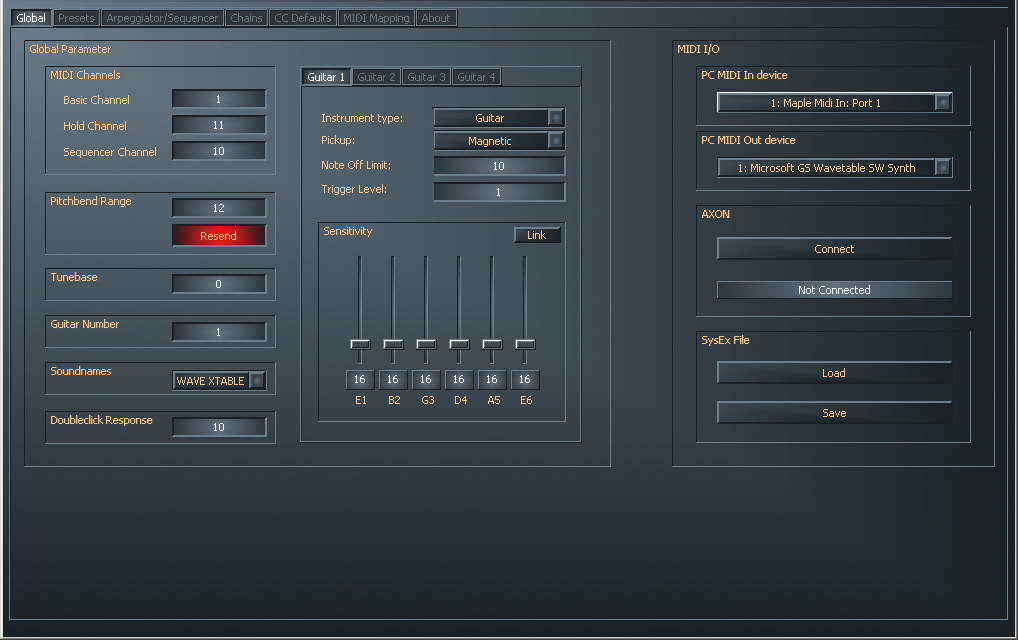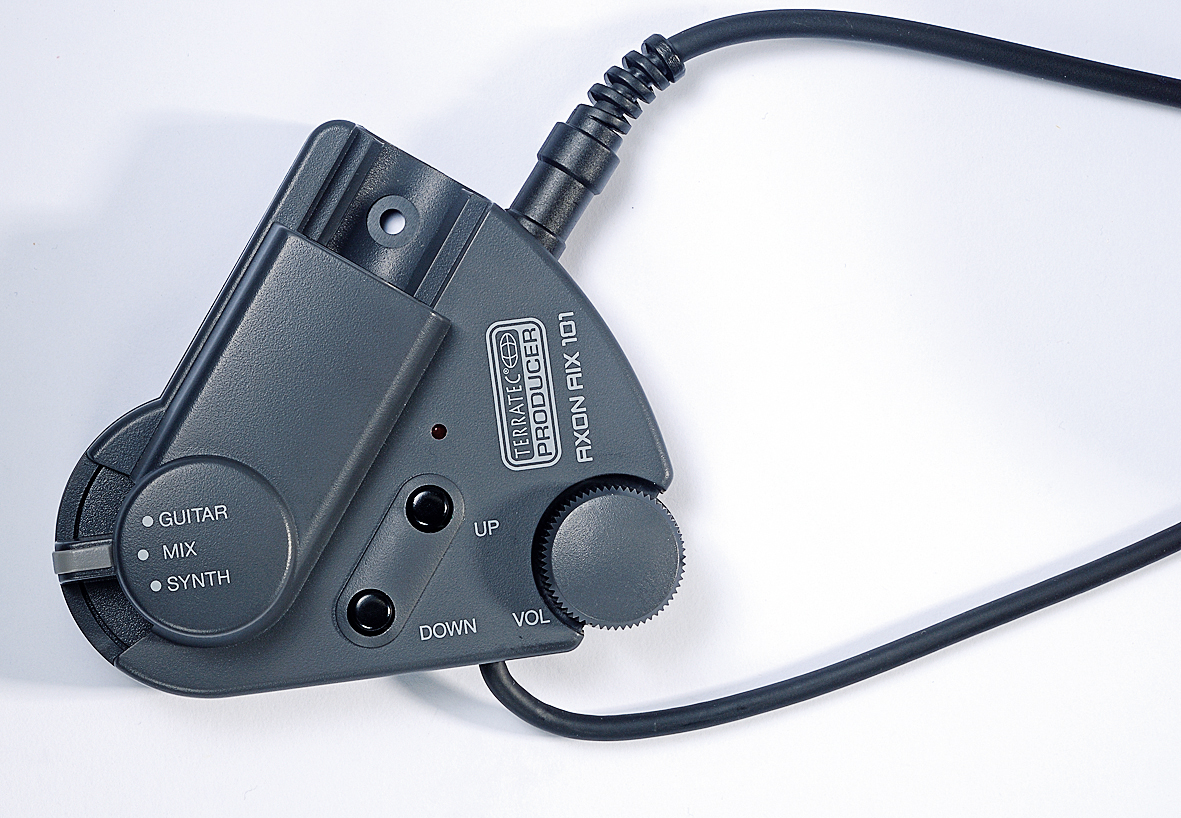MusicRadar Verdict
It might look and feel old-fashioned, but the technology that powers the Axon system is state of the art. There's nothing else quite like it.
Pros
- +
Exceptional note-tracking. Pick-position-to-MIDI-controller function works well. Great-sounding new synth module. Excellent new editing software.
Cons
- -
Note-off sensitivity hasn't improved. Sound module too 'hidden'.
MusicRadar's got your back

Terratec Axon AX 100 II

Terratec Axon AX 100 II
The Axon MIDI guitar controller is a clever piece of kit that enables you to convert a guitar's signal into digital sound.
Using an Axon pickup or a supported third-party one, your guitar's signal is fed to the Axon AX 100 controller. Here, it's converted to MIDI and fed to a built-in sound module and (via the MIDI Output) your computer.
Axon's system is unlike anything else on the market. Typically, MIDI guitar systems work like guitar tuners - they 'listen' to the sound and work out its pitch. This might seem like an obvious approach, but the time taken to detect the note is far too long.
Axon's system works more like a submarine's sonar than a guitar tuner. By listening to the reflection patterns of the guitar pick as it travels up and down the string, Axon can determine the length of the string and therefore its pitch.
Axon can also detect the position the pick was at when it plucked the string. This all happens straightaway, ensuring that latency isn't an issue.
The original Axon system was a revelation, but the MkII update brings improved firmware, a brand new soundset, PC and Mac control software and a 'guided tour' DVD.
The Axon AX 100 MkII can be bought as an upgrade kit, or as a new 19-inch rackmount module. Not all previous Axon units can be upgraded to MkII - only the ones with a large Display Contrast knob are compatible. Unless you have experience of replacing EPROM chips, we recommend that you get an experienced hardware engineer to perform the upgrade.
To use the AX 100 MkII you'll need to buy the correct type of guitar pickup. Axon's own model - the AIX 101 - must be mounted less than 20mm away from the bridge saddles or it won't work properly (we tried it). As such, the AIX 101 won't suit all guitars and you may have to buy a different type of pickup.
To test if you've got the pickup positioned properly, you just need to see how well it works with the AX 100. If the position isn't quite right, the chances are that you'll have problems, with the G-string in particular.
Once the pickup position is correct, though, the accuracy and speed of Axon's note tracking is incredible - if you're not getting excellent results, you can be pretty sure that it needs changing.
Getting to grips
When you first power-up the AX 100 and start playing, you'll hear the slightly embarrassing sound of a grand piano (playing piano on a guitar feels like an unnatural and shameful act).
Once you start exploring the controls, you'll probably come unstuck pretty quickly, as the front panel of the AX 100 is - even by rackmount standards - pretty arcane. The manual doesn't help either, as it has no holistic overview.
To remedy this situation, all you need to do is hook up Axon's MIDI ports and install the new editor software. When you flick through its pages, the configuration and operation of the AX 100 become obvious.
Through this new software, the power of the Axon system is both revealed and simplified. You learn that splitting the guitar by fretboard and pick position puts 12 sounds on the guitar simultaneously, and that you can have a completely different sound (played as a sustained chord pad) underneath everything else.
You're also able to tweak things - such as the reverb levels or filter cutoff - as you play. All you need to do is pick in the relevant places.
As you discover these features, you realise that the Axon is certainly no toy or gimmick. It's an advanced musical instrument in its own right.
Sounds
The AX 100 contains a General MIDI sound module which is both GS- and XG-compatible. That grand piano sound we mentioned isn't going to win any awards, but it's certainly nothing to be ashamed of, and there's no shortage of credible sounds elsewhere in the soundbank.
To get the best from the sound module, however, you need additional XG- or GS-editing software.
It should be noted that the true sound of your guitar comes straight out of the back panel, and isn't incorporated into Axon's system at all.
This might seem surprising, but the raw sound of your guitar isn't very useful, since you'll want to pipe it through effects and/or a guitar amp before you mix it with the Axon's output.
Because of its 19-inch rack format and the lack of any USB connectivity, the AX 100 MkII does have a slightly old-fashioned feel to it.
However, the use of standard MIDI ports and audio jacks means that its connectivity options are much more flexible than if it were a USB-only device. The note-off sensitivity could still do with improving, but at least the sustain pedal gives you a workaround.
Summary
Ultimately, Axon's system remains the best choice if you want to turn guitar data into MIDI and thanks to this update, it now comes with a top-notch set of 500 sounds and ten drumkits. Well worth the price.
Computer Music magazine is the world’s best selling publication dedicated solely to making great music with your Mac or PC computer. Each issue it brings its lucky readers the best in cutting-edge tutorials, need-to-know, expert software reviews and even all the tools you actually need to make great music today, courtesy of our legendary CM Plugin Suite.
“Nope, it’s real”: Jack Black and Keanu Reeves both confirmed for upcoming Weezer movie
“An amazing piece of history from the British blues scene”: Robert Plant is selling a trove of gear for charity – including a John Birch-modded ‘62 Stratocaster with two switches that once belonged to Stan Webb of Chicken Shack
“I was like ‘Wow, Coldplay were definitely listening to Radiohead and trying to make their version of it’": Porter Robinson says that he only recently discovered that Coldplay used to sound a bit like Radiohead










